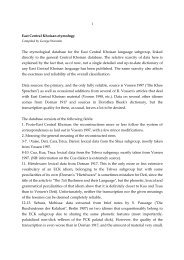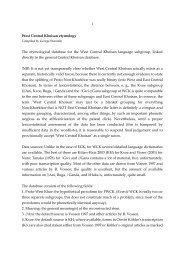Annotated Swadesh wordlists for the Hurrian language - Starling
Annotated Swadesh wordlists for the Hurrian language - Starling
Annotated Swadesh wordlists for the Hurrian language - Starling
Create successful ePaper yourself
Turn your PDF publications into a flip-book with our unique Google optimized e-Paper software.
[Text version of database, created 31/10/2011].<br />
1<br />
<strong>Annotated</strong> <strong>Swadesh</strong> <strong>wordlists</strong> <strong>for</strong> <strong>the</strong> <strong>Hurrian</strong> <strong>language</strong> (Hurro-Urartian family).<br />
Languages included: <strong>Hurrian</strong> [hur-hrr].<br />
Data sources.<br />
André-Salvini & Salvini 1998 = André-Salvini, B. & Salvini, M. Un nouveau<br />
vocabulaire trilingue sumérien-akkadien-hourrite de Ras Shamra. In: Studies on <strong>the</strong><br />
Civilization and Culture of Nuzi and <strong>the</strong> <strong>Hurrian</strong>s 9 (1998). P. 3-31.<br />
André-Salvini & Salvini 1999a = André-Salvini, B. & Salvini, M. La colonne I du<br />
vocabulaire S a trilingue RS 94-2939. In: SMEA 41/1 (1999). P. 145-148.<br />
André-Salvini & Salvini 1999b = André-Salvini, B. & Salvini, M. A new trilingual<br />
vocabulary from Ras Shamra and <strong>the</strong> relationship between <strong>Hurrian</strong> and Urartian. In:<br />
Studies on <strong>the</strong> Civilization and Culture of Nuzi and <strong>the</strong> <strong>Hurrian</strong>s 10 (1999). P. 267-275.<br />
André-Salvini & Salvini 2002 = André-Salvini, B. & Salvini, M. The bilingual stele of<br />
Rusa I from Movana (West-Azerbaijan, Iran). In: SMEA 44/1 (2002). P. 5-66.<br />
Campbell 2007 = Campbell, D. Mood and modality in <strong>Hurrian</strong>. Ph.D. diss., The<br />
University of Chicago, 2007.<br />
Campbell 2008 = Campbell, D. Split ergativity in <strong>Hurrian</strong>. In: Zeitschrift für<br />
Assyriologie 98 (2008). P. 262-294.<br />
Catsanicos 1996 = Catsanicos, J. L'apport de la bilingue de Hattusa à la lexicologie<br />
hourrite. In: Amurru 1: Mari, Ébla et les hourrites. Paris, 1996. P. 197-296.<br />
CdTU = M. Salvini. Corpus dei testi urartei. Vol. 1-3. Roma, 2008.<br />
de Martino & Giorgieri 2007 = de Martino, S. & Giorgieri, M. Hurritisch ašti<br />
"(Ehe)frau". In: Altorientalische Forschungen 34/1 (2007) (Festschrift für I. Wegner). S.<br />
126-148.<br />
Dietrich & Mayer 1994 = Dietrich, M. & Mayer, W. Hurritische<br />
Weihrauch-Beschwörungen in ugaritischer Alphabetschrift. In: Ugarit-Forschungen 26<br />
(1994). P. 73-112.<br />
Dietrich & Mayer 1997 = Dietrich, M. & Mayer, W. Ein hurritisches Totenritual für<br />
Ammištamru III. (KTU 1.125). In: B. Pongratz-Leisten et al. (eds.). Ana šadî Labnāni lū<br />
allik: Beiträge zu altorientalischen und mittelmeerischen Kulturen: Festschrift für Wolfgang
Röllig (= AOAT 247). Kevelaer / Neukirchen-Vluyn, 1997. P. 79-89.<br />
2<br />
Dietrich & Mayer 2010 = Dietrich, M. & Mayer, W. Der hurritische Brief des Dušratta<br />
von Mīttānni an Amenḫotep III. Text - Grammatik - Kopie (= AOAT 382). Münster:<br />
Ugarit-Verlag, 2010.<br />
Dijkstra 1993a = Dijkstra, M. The Ugaritic-<strong>Hurrian</strong> sacrificial hymn to El (RS 24.278 =<br />
KTU 1.128). In: Ugarit-Forschungen 25 (1993). P. 157-162.<br />
Dijkstra 1993b = Dijkstra, M. The Akkado-<strong>Hurrian</strong> bilingual wisdom-text RS 15.010<br />
reconsidered. In: Ugarit-Forschungen 25 (1993). P. 163-171.<br />
Dijkstra 2006 = Dijkstra, M. The myth of apši "<strong>the</strong> (sea)dragon" in <strong>the</strong> <strong>Hurrian</strong><br />
tradition. In: Ugarit-Forschungen 37 (2006). P. 315-323.<br />
Giorgieri 1998 = Giorgieri, M. Die erste Beschwörung der 8. Tafel des Šalašu-Rituals.<br />
In: Studies on <strong>the</strong> Civilization and Culture of Nuzi and <strong>the</strong> <strong>Hurrian</strong>s 9 (1998). P. 71-86.<br />
Giorgieri 2000 = Giorgieri, M. Schizzo grammaticale della lingua hurrica. In: S. de<br />
Martino et al. (eds.). La civiltà dei Hurriti (= La parola del Passato 55). Napoli,<br />
Macchiaroli Editore, 2000. P. 171-277.<br />
Giorgieri 2001 = Giorgieri, M. Die hurritische Fassung des Ullikummi-Lieds und ihre<br />
hethitische Parallele. In: G. Wilhelm (ed.). Akten des IV. Internationalen Kongresses für<br />
Hethitologie, Würzburg, 4.-8. Oktober 1999 (= StBoT 45). Wiesbaden, 2001.<br />
Girbal 1994 = Girbal, Chr. šummi im Boğazköy-Hurritischen. In: Altorientalische<br />
Forschungen 21/1 (1994). S. 171-175.<br />
Girbal 2001 = Girbal, Chr. Selbständige Pronomina der ersten Person Singular im<br />
Urartäischen. In: Th. Richter et al. (eds.). Kulturgeschichten: Altorientalistische Studien für<br />
Volkert Haas zum 65. Geburtstag. Saarbrücken, 2001. S. 139-144.<br />
Girbal 2004 = Girbal, Chr. Notizen zum Urartäischen. In: SMEA 46/1 (2004). P. 25-28.<br />
Girbal 2010 = Girbal, Chr. Urartäisch barzani zelde. In: Altorientalische Forschungen<br />
37/1 (2010). S. 153-158.<br />
GLH = E. Laroche. Glossaire de la langue hourrite. Paris, 1980.<br />
Görke 2010 = Görke, S. Das Ritual der Aštu (CTH 490). Rekonstruktion und Tradition<br />
eines hurritisch-hethitischen Rituals aus Boğazköy-Ḫattuša. Brill, 2010.<br />
Haas 1993 = Haas, V. Hurritologische Miszellen. In: Altorientalische Forschungen 20/2<br />
(1993). S. 261-268.<br />
Haas 1998a = Haas, V. Die hurritischen Ritualtermini in hethitischem Kontext. 2 vols<br />
(ChS 1/9). Roma, 1998.
Haas 1998b = Haas, V. Der heilkundige Jäger. In: SMEA 40/1 (1998). P. 143-150.<br />
3<br />
Haas & Wegner 2004 = Haas, V. & Wegner, I. Das Gegenwortpaar 'wahr' und 'falsch'<br />
im Hurritischen. In: D. Groddek & S. Rößle (eds). Šarnikzel: Hethitologische Studien zum<br />
Gedenken an Emil Orgetorix Forrer. Dresden, 2004. P. 339-344.<br />
Haas & Wegner 2010 = Haas, V. & Wegner, I. Beiträge zum hurritischen Lexikon:<br />
Die hurritischen Verben ušš- 'gehen' und ašš- 'abwaschen, abwischen'. In: J. Klinger et al.<br />
(eds.). Investigationes Anatolicae: Gedenkschrift für Erich Neu (StBoT 52). Wiesbaden, 2010.<br />
S. 97-110.<br />
Hazenbos 2005 = Hazenbos, J. Hurritisch und Urartäisch. In: M. P. Streck (ed.).<br />
Sprachen des Alten Orients. Darmstadt, 2005. S. 135-158.<br />
Hrůša 2010 = Hrůša, I. Die akkadische Synonymenliste malku - šarru. Eine Textedition<br />
mit Übersetzung und Kommentar (= AOAT 50). Ugarit-Verlag, 2010.<br />
Huehnergard 1987/2008 = Huehnergard, J. Ugaritic Vocabulary in Syllabic<br />
Transcription (Harvard Semitic Studies 32). 1 st ed.: Atlanta, 1987; 2 nd repr. ed.: Winona<br />
Lake, 2008, with addenda on pp. 375-406.<br />
Kassian 2011 = Kassian, A. Hurro-Urartian from <strong>the</strong> lexicostatistical viewpoint. In:<br />
Ugarit-Forschungen. Bd 42, 2010 [2011].<br />
Krebernik 2001 = Krebernik, M. Tall Bi'a / Tuttul. Bd 2: Die Altorientalischen<br />
Schriftfunde. Saarbrücker Druckerei und Verlag, 2001.<br />
Lam 2007 = Lam, J. The <strong>Hurrian</strong> Section of <strong>the</strong> Ugaritic Ritual Text RS 24.643 (KTU<br />
1.148). In: Ugarit-Forschungen 38 (2007). P. 399-413.<br />
LHL 1 = S. de Martino, M. Giorgieri. Literatur zum hurritischen Lexikon. Bd 1: A.<br />
LoGisma editore, 2008.<br />
Neu 1996 = Neu, E. Das hurritische Epos der Freilassung. I: Untersuchungen zu einem<br />
hurritisch-hethitischen Textensemble aus Hattuša (Studien zu den Boğazköy Texten 32).<br />
Wiesbaden, 1996.<br />
Neu 2003 = Neu, E. Die hurritischen Pronomina der hurritisch-hethitischen Bilingue<br />
aus Hattuša. In: G. Beckman et al. (eds.). Hittite Studies in Honor of Harry A. Hoffner Jr. on<br />
<strong>the</strong> Occasion of His 65 th Birthday. Eisenbrauns, 2003. P. 297-307.<br />
Prechel & Richter 2001 = Prechel, D. & Richter, Th. Abrakadabra oder Althurritisch:<br />
Betrachtungen zu einigen altbabylonischen Beschwörungstexten. In: Th. Richter et al.<br />
(eds.). Kulturgeschichten: Altorientalistische Studien für Volkert Haas zum 65. Geburtstag.<br />
Saarbrücken, 2001. S. 333-371.
4<br />
Richter 2005 = Richter, Th. Kleine Beiträge zum hurritischen Wörterbuch. In:<br />
Altorientalische Forschungen 32/1 (2005). S. 23-44.<br />
Röseler 1999 = Röseler, I. Hurritologische Miszellen. In: Studies on <strong>the</strong> Civilization and<br />
Culture of Nuzi and <strong>the</strong> <strong>Hurrian</strong>s 10 (1999). P. 393-400.<br />
Salvini & Wegner 2004 = Salvini, M. & Wegner, I. Die mythologischen Texte (ChS 1/6).<br />
Roma, 2004.<br />
Strauß 2001 = Strauß, R. Eine Rezeptur und Beschwörung für die Zubereitung von<br />
"Weihwasser" in dem Ritual CTH 471. In: Th. Richter et al. (eds.). Kulturgeschichten:<br />
Altorientalistische Studien für Volkert Haas zum 65. Geburtstag. Saarbrücken, 2001. S.<br />
405-416.<br />
2005.<br />
Trémouille 2005 = Trémouille, M.-C. Texte verschiedenen Inhalts (ChS 1/8). Roma,<br />
Ünal 1998 = Ünal, A. Hittite and <strong>Hurrian</strong> cunei<strong>for</strong>m tablets from Ortaköy (Çorum),<br />
Central Turkey. Istanbul, 1998.<br />
Wegner 1992 = Wegner, I. Die selbständigen personalpronomina des Hurritischen.<br />
In: SMEA 29 (1992). P. 227-237.<br />
Wegner 1995 = Wegner, I. Die hurritischen Körperteilbezeichnungen. In: Zeitschrift<br />
für Assyriologie 85 (1995). S. 116-126.<br />
Wegner 2007 = Wegner, I. Hurritisch. Eine Einführung. 2 nd rev. ed. Wiesbaden, 2007.<br />
Wegner 2010 = Wegner, I. Das hurritische Fragepronomen aunni (a-ú-u(n)-ni) =<br />
hethitisch kuit. In: J. C. Fincke (ed.). Festschrift für Gernot Wilhelm anläßlich seines 65.<br />
Geburtstages am 28 Januar 2010. ISLET, 2010. P. 403-410.<br />
Wilhelm 1984 = Wilhelm, G. Die Inschrift auf der Statue der Tatu-Hepa und die<br />
hurritischen deiktischen Pronomina. In: SMEA 24 (1984). P. 215-222.<br />
Wilhelm 1991 = Wilhelm, G. A <strong>Hurrian</strong> Letter from Tell Brak. In: Iraq 53 (1991). P.<br />
159-168.<br />
Wilhelm 1993 = Wilhelm, G. Zur Grammatik und zum Lexikon des Hurritischen. In:<br />
Zeitschrift für Assyriologie 83 (1993). P. 99-118.<br />
Wilhelm 1998a = Wilhelm, G. Hurr. šinussi 'Scheuklappe'? In: Studies on <strong>the</strong><br />
Civilization and Culture of Nuzi and <strong>the</strong> <strong>Hurrian</strong>s 9 (1998). P. 173-176.<br />
Wilhelm 1998b = Wilhelm, G. Zur Suffixaufnahme beim Instrumental. In: Studies on<br />
<strong>the</strong> Civilization and Culture of Nuzi and <strong>the</strong> <strong>Hurrian</strong>s 9 (1998). P. 177-180.<br />
Wilhelm 1998c = Wilhelm, G. Die Inschrift des Tišatal von Urkeš. In: G. Buccellati &
5<br />
M. Kelly-Buccellati (eds.). Urkesh and <strong>the</strong> <strong>Hurrian</strong>s Studies in Honor of Lloyd Cotsen<br />
(Urkesh/Mozan Studies 3). Malibu, 1998. P. 117-143.<br />
Wilhelm 2008a = Wilhelm, G. <strong>Hurrian</strong>. In: R. D. Woodard (ed.). The Ancient<br />
Languages of Asia Minor. Cambridge, 2008. P. 81-104.<br />
Wilhelm 2008b = Wilhelm, G. Urartian. In: R. D. Woodard (ed.). The Ancient<br />
Languages of Asia Minor. Cambridge, 2008. P. 105-123.<br />
Yakubovich 2011 = Yakubovich, I. Morphological Negation in Urartian. In: A.<br />
Kosyan et al. (eds.). Urartu and its Neighbors. Festschrift in honor of Nicolay Harutyunyan in<br />
occasion of his 90 th birthday (= Aramazd. Armenian Journal of Near Eastern Studies, No.<br />
5). Yerevan, 2011. P. 141-165.<br />
1963.<br />
Дьяконов 1963 = Дьяконов, И. М. Урартские письма и документы. Ленинград,<br />
КУКН = Н. В. Арутюнян. Корпус урартских клинообразных надписей. Ереван, 2003.<br />
Хачикян 2010a = Хачикян, М. Л. Хурритский язык. In: Языки мира: Древние<br />
реликтовые языки Передней Азии. Москва: РАН, Институт языкознания, 2010. С.<br />
126-149.<br />
Хачикян 2010b = Хачикян, М. Л. Урартский язык. In: Языки мира: Древние<br />
реликтовые языки Передней Азии. Москва: РАН, Институт языкознания, 2010. С.<br />
149-168.<br />
Notes.<br />
It is obvious that, during <strong>the</strong> millennium that attested <strong>Hurrian</strong> was spoken, <strong>the</strong>re<br />
were a number of <strong>Hurrian</strong> dialects that should differ in <strong>the</strong>ir basic vocabularies (<strong>the</strong><br />
most obvious instance is <strong>the</strong> verb 'to go'). Due to <strong>the</strong> scantiness of data, it is impossible,<br />
however, to adhere to <strong>the</strong> principle of chronological and dialectal integrity (as opposed,<br />
e.g., to <strong>the</strong> situation with <strong>the</strong> Ancient Greek, cf. annotated <strong>Swadesh</strong> <strong>wordlists</strong> <strong>for</strong> <strong>the</strong><br />
Greek group of <strong>the</strong> Indo-European family). The <strong>Hurrian</strong> list below is cumulative, that<br />
is, it includes all available <strong>for</strong>ms from any dialects. The following sigla are used <strong>for</strong><br />
<strong>Hurrian</strong> sources.<br />
The so-called Old <strong>Hurrian</strong> period, ca. <strong>the</strong> late-3 rd - <strong>the</strong> mid-2 nd millennia: Tišatal (<strong>the</strong><br />
royal inscription of Tišatal, endan of Urkeš), OBab. (ca. 10 tablets with invocations,
6<br />
presumably all from <strong>the</strong> site of Larsa in sou<strong>the</strong>rn Babylonia), Mari (6 tablets from Mari),<br />
Bo.Bil. (<strong>the</strong> <strong>Hurrian</strong>-Hittite bilingual series "Song of Release").<br />
The so-called New <strong>Hurrian</strong> period, ca. <strong>the</strong> mid-2 nd - <strong>the</strong> late-2 nd millennia: Mit. (<strong>the</strong><br />
Mittani Letter), Bogh. (texts from <strong>the</strong> Hittite capital's archives, modern Boğazköy, o<strong>the</strong>r<br />
than Bo.Bil.), Ugar.A. and Ugar.C. (texts from <strong>the</strong> Ugaritic archives written in <strong>the</strong><br />
alphabetic or syllabic cunei<strong>for</strong>m script respectively), Nuzi, Qatna, Msk., Ort., Tell Brak<br />
(texts from Nuzi, Qaṭna, Tell Meskene [Emar], Ortaköy and Tell Brak respectively),<br />
Subar. ("Subarian" glosses in Assyro-Babylonian sources).<br />
<strong>Hurrian</strong> and Urartian <strong>for</strong>ms are quoted in traditional cunei<strong>for</strong>m transcription, e.g.,<br />
<strong>the</strong> main <strong>Hurrian</strong> and Urartian sibilant is rendered as š (phonetically apparently [s]),<br />
geminated consonants as double letters (tt, kk, etc.), velar fricatives as h/hh, front<br />
affricates as z/zz, and so on. We do not discriminate between two <strong>Hurrian</strong> u-phonemes<br />
(u & o), since this difference is irrelevant <strong>for</strong> <strong>the</strong> current investigation. The problem of<br />
inventory and phonetic realisation of <strong>Hurrian</strong> labial consonants has not been solved so<br />
far; p, f & w in <strong>the</strong> <strong>Hurrian</strong> <strong>for</strong>ms below are used according to <strong>the</strong> Hurritological<br />
tradition.<br />
Never<strong>the</strong>less, in order to adhere to <strong>the</strong> GLD transcriptional standard, which<br />
facilitates automatic comparison between various <strong>language</strong>s and <strong>language</strong> groups, we<br />
have to rewrite <strong>Hurrian</strong> h/hh as ɣ/xx, z/zz as ʒ/cc. This only affects <strong>for</strong>ms in <strong>the</strong> main<br />
field. According to general GLD principles, traditional transcription with h & z is added<br />
within curly brackets {}.<br />
Urartian data, when available, are quoted in <strong>the</strong> notes to <strong>the</strong> corresponding <strong>Hurrian</strong><br />
entries.<br />
The current presentation is actually a short version of <strong>the</strong> paper [Kassian 2011]. This<br />
database only contains <strong>Hurrian</strong> and Urartian terms whose <strong>Swadesh</strong> meanings are<br />
established with a reasonable degree of probability, along with references to <strong>the</strong><br />
sources. For additional synchronic as well as etymological data <strong>the</strong> reader might refer to<br />
[Kassian 2011].<br />
Database compiled and annotated by: A. Kassian, October 2011.
1. ALL<br />
<strong>Hurrian</strong> šua-lla (1).<br />
References and notes:<br />
<strong>Hurrian</strong>: GLH: 240; Dietrich & Mayer 2010: 204, 261; Wegner 2007: 84; Girbal 1994: 175.<br />
2. ASHES<br />
Paradigm: sg. šue ~ šua-nna 'all (totus)' [Mit., Bogh.] / pl. šua-lla 'all (omnis)' [Mit.].<br />
7<br />
Urartian: sg. šui-ni- 'totus' / pl. šuy-a- 'omnis' [КУКН: 465]; [CdTU 2: 200]; [André-Salvini & Salvini 2002: 14 f.]. An<br />
etymological cognate of <strong>the</strong> main <strong>Hurrian</strong> term.<br />
<strong>Hurrian</strong> šal-mi (2).<br />
References and notes:<br />
<strong>Hurrian</strong>: André-Salvini & Salvini 1998: 15; Huehnergard 1987/2008: 378.<br />
3. BARK<br />
Ugar.C.<br />
References and notes:<br />
<strong>Hurrian</strong>: Unattested.<br />
4. BELLY<br />
References and notes:<br />
<strong>Hurrian</strong>: Unattested.<br />
5. BIG<br />
<strong>Hurrian</strong> tal-mi ~ tal-a-mi (1).
References and notes:<br />
<strong>Hurrian</strong>: GLH: 253; Wegner 2007: 282; Dietrich & Mayer 2010: 263; Huehnergard 1987/2008: 381; André-Salvini & Salvini 1998: 18.<br />
6. BIRD<br />
Mit., Ugar.C., Bogh.<br />
<strong>Hurrian</strong> eradi (1).<br />
References and notes:<br />
<strong>Hurrian</strong>: Wegner 2007: 255; André-Salvini & Salvini 1998: 13; Haas & Wegner 2004: 341; Görke 2010: 336.<br />
7. BITE<br />
References and notes:<br />
<strong>Hurrian</strong>: Unattested.<br />
8. BLACK<br />
Ugar.C., Bogh.<br />
<strong>Hurrian</strong> time-ri ~ tima-ri (1).<br />
References and notes:<br />
<strong>Hurrian</strong>: Neu 1996: 246; Catsanicos 1996: 227; Wegner 2007: 53, 285.<br />
9. BLOOD<br />
Bo.Bil., Bogh.<br />
<strong>Hurrian</strong> cur-gi {zur-gi} (1).<br />
References and notes:<br />
<strong>Hurrian</strong>: GLH: 309; Haas 1998a: 254.<br />
10. BONE<br />
Bogh., Msk.<br />
8
References and notes:<br />
<strong>Hurrian</strong>: Unattested.<br />
11. BREAST<br />
<strong>Hurrian</strong> neɣer-ni {neher-ni} (1).<br />
References and notes:<br />
9<br />
<strong>Hurrian</strong>: Catsanicos 1996: 280; Huehnergard 1987/2008: 382; André-Salvini & Salvini 1998: 14; Wegner 1995: 121; Wegner 2007: 269;<br />
Haas 1993: 268.<br />
12. BURN TR.<br />
<strong>Hurrian</strong> am- (1).<br />
References and notes:<br />
Bo.Bil. ('brisket'), Ugar.C. ('chest').<br />
<strong>Hurrian</strong>: LHL 1: 70; Wegner 2007: 246; Catsanicos 1996: 232.<br />
Bo.Bil.<br />
Urartian: am-, am-ašt- [КУКН: 434], [CdTU 2: 43-44], [André-Salvini & Salvini 1999b: 272-273]. An etymological<br />
cognate of <strong>the</strong> <strong>Hurrian</strong> term.<br />
13. CLAW (NAIL)<br />
References and notes:<br />
<strong>Hurrian</strong>: Unattested.<br />
14. CLOUD<br />
References and notes:<br />
<strong>Hurrian</strong>: Unattested.<br />
15. COLD<br />
References and notes:
<strong>Hurrian</strong>: Unattested.<br />
16. COME<br />
<strong>Hurrian</strong> un- (1).<br />
References and notes:<br />
<strong>Hurrian</strong>: GLH: 282; Wegner 2007: 289 f.; Dietrich & Mayer 1994: 87, 90; Dijkstra 1993a: 160; Strauß 2001: 414; Görke 2010: 342.<br />
17. DIE<br />
Bogh., Mit., Ugar.A.<br />
10<br />
Urartian: nun-a- [КУКН: 456], [CdTU 2: 163-164]. Probably an etymological cognate of <strong>the</strong> <strong>Hurrian</strong> term, although<br />
details are unclear (a reduplication: n-un < *un-un?).<br />
References and notes:<br />
<strong>Hurrian</strong>: Unattested.<br />
18. DOG<br />
<strong>Hurrian</strong> erwi ~ erbi (1).<br />
References and notes:<br />
<strong>Hurrian</strong>: GLH: 83; Wegner 2007: 255; Catsanicos 1996: 279; André-Salvini & Salvini 1998: 11.<br />
19. DRINK<br />
<strong>Hurrian</strong> al- (1).<br />
References and notes:<br />
<strong>Hurrian</strong>: LHL 1: 51.<br />
20. DRY<br />
Bo.Bil., Bogh. Ugar.C.<br />
Bogh.<br />
References and notes:
<strong>Hurrian</strong>: Unattested.<br />
21. EAR<br />
<strong>Hurrian</strong> nui ~ nuɣi {nui ~ nuhi} (1).<br />
References and notes:<br />
<strong>Hurrian</strong>: Wegner 1995: 121 f.; Catsanicos 1996: 273; Görke 2010: 71 f.; Wilhelm 1991: 166.<br />
22. EARTH<br />
<strong>Hurrian</strong> eše (1).<br />
References and notes:<br />
Bo.Bil. (nui), Bogh. (nui ~ nuhi), Tell Brak (nui).<br />
11<br />
<strong>Hurrian</strong>: Wegner 2007: 256; Catsanicos 1996: 230 f.; Dietrich & Mayer 2010: 240; Dietrich & Mayer 1994: 87; Prechel & Richter 2001:<br />
359; Ünal 1998: 60; Wilhelm 1993: 111 ff.; Görke 2010: 336; GLH: 83 f. (erroneously glossed as 'sky').<br />
23. EAT<br />
OBab., Bo.Bil., Ugar.A. (e ḏ), Ugar.C., Mit., Bogh., Ort. Polysemy: 'earth (world) / earth (soil) / position / place'<br />
Urartian: ḳiura- ~ ḳira- 'earth (world); earth (soil); land' [КУКН: 459], [CdTU 2: 178].<br />
The Proto-HU term <strong>for</strong> 'earth (soil)' was apparently *eSi, because <strong>the</strong> meaning shift 'earth (soil)' > 'ground' > 'place' is<br />
natural, whereas 'place' > 'earth (soil)' seems typologically odd.<br />
<strong>Hurrian</strong> ul- (1).<br />
References and notes:<br />
<strong>Hurrian</strong>: Catsanicos 1996: 216.<br />
24. EGG<br />
Bo.Bil.<br />
References and notes:<br />
<strong>Hurrian</strong>: Unattested.<br />
25. EYE<br />
<strong>Hurrian</strong> ši ~ šiɣi {ši ~ šihi} (1).<br />
References and notes:
<strong>Hurrian</strong>: Catsanicos 1996: 231, 270; Wegner 1995: 124 f.; Wilhelm 1998a: 174; Görke 2010: 71, 76.<br />
26. FAT N.<br />
<strong>Hurrian</strong> aše (1).<br />
References and notes:<br />
Bo.Bil. (ši), Bogh. (ši ~ šihe).<br />
<strong>Hurrian</strong>: Catsanicos 1996: 278; Neu 1996: 115; Haas 1998b: 143; Wegner 2007: 250; LHL 1: 117.<br />
Bo.Bil.<br />
27. FEATHER<br />
References and notes:<br />
<strong>Hurrian</strong>: Unattested.<br />
28. FIRE<br />
<strong>Hurrian</strong> tari (1).<br />
References and notes:<br />
<strong>Hurrian</strong>: Catsanicos 1996: 231; GLH: 257; Huehnergard 1987/2008: 378; André-Salvini & Salvini 1998: 18.<br />
29. FISH<br />
References and notes:<br />
<strong>Hurrian</strong>: Unattested.<br />
30. FLY V.<br />
References and notes:<br />
<strong>Hurrian</strong>: Unattested.<br />
Bo.Bil., Mit., Bogh., Ugar.C.<br />
12
31. FOOT<br />
<strong>Hurrian</strong> uri ~ ur-ni (1).<br />
References and notes:<br />
13<br />
<strong>Hurrian</strong>: Wegner 2007: 291; Wegner 1995: 125 f.; Catsanicos 1996: 204; Huehnergard 1987/2008: 379; André-Salvini & Salvini 1998:<br />
21; André-Salvini & Salvini 1999: 272; Prechel & Richter 2001: 356.<br />
32. FULL<br />
References and notes:<br />
<strong>Hurrian</strong>: Unattested.<br />
33. GIVE<br />
<strong>Hurrian</strong> ar- (1).<br />
References and notes:<br />
OBab., Bo.Bil., Bogh., Ugar.C.<br />
Urartian: kuri [КУКН: 452], [CdTU 2: 137].<br />
The relationship between Hurr. uri 'foot', Hurr. ugri 'leg of <strong>the</strong> table' and Urart. kuri 'foot' is unclear.<br />
<strong>Hurrian</strong>: LHL 1: 96; Wegner 2007: 248; GLH: 52; Huehnergard 1987/2008: 34-35, 70; Catsanicos 1996: 245; Görke 2010: 335.<br />
34. GOOD<br />
Bo.Bil., Mit., Bogh., Ugar.C., Tell Brak.<br />
Urartian: ar-, ar-u- [КУКН: 435, 436], [CdTU 2: 46, 50]. An etymological cognate of <strong>the</strong> <strong>Hurrian</strong> term.<br />
<strong>Hurrian</strong> waɣri ~ waɣr-uši {wahri ~ wahr-uši} (1).<br />
References and notes:<br />
<strong>Hurrian</strong>: GLH: 292; Wegner 2007: 270; André-Salvini & Salvini 1998: 22; Catsanicos 1996: 281; Salvini & Wegner 2004: 177; Richter<br />
2005: 27.<br />
35. GREEN<br />
References and notes:<br />
Bo.Bil., Mit., Bogh., Ugar.C., Ugar.A., Qatna, Msk.
<strong>Hurrian</strong>: Unattested.<br />
36. HAIR<br />
References and notes:<br />
<strong>Hurrian</strong>: Unattested.<br />
37. HAND<br />
<strong>Hurrian</strong> šu-ni (1).<br />
References and notes:<br />
14<br />
<strong>Hurrian</strong>: Wegner 2007: 219, 281; Wegner 1995: 125; Girbal 1994: 171-173; Catsanicos 1996: 200; GLH: 242, 243; Görke 2010: 340; Ünal<br />
1998: 59, 64.<br />
38. HEAD<br />
Bo.Bil. (šuni), Bogh. (šuni, šummuni ~ šumuni), Ort. (šuni), Ugar.C. (šumuni).<br />
Urartian: šu-, see [Girbal 2004: 26 f.] (accepted in [CdTU A 14-1 obv. 10]), and [CdTU A 10-5 obv. 19']. An<br />
etymological cognate of <strong>the</strong> <strong>Hurrian</strong> term.<br />
<strong>Hurrian</strong> paɣi {pahi} (1).<br />
References and notes:<br />
<strong>Hurrian</strong>: GLH: 192; Wegner 2007: 270; André-Salvini & Salvini 1998: 14; Salvini & Wegner 2004: 177; Ünal 1998: 64; Görke 2010: 138<br />
f.<br />
39. HEAR<br />
Mari, Bogh., Ort., Ugar.C., Ugar.A.<br />
<strong>Hurrian</strong> xaš- {haš-} (1).<br />
References and notes:<br />
<strong>Hurrian</strong>: Wegner 2007: 258; GLH, 95; Catsanicos 1996: 267, 272; Dietrich & Mayer 2010: 242; Wilhelm 1991: 166; Wilhelm 1998c: 140;<br />
Campbell 2008: 283; Hrůša 2010: 92 [l. 12], 239.<br />
40. HEART<br />
Tišatal, Bo.Bil., Bogh., Mit., Tell Brak, Subar.<br />
Urartian: haš-i-, haš-u- [КУКН: 446], [CdTU 2: 97, 98]. An etymological cognate of <strong>the</strong> <strong>Hurrian</strong> term.
<strong>Hurrian</strong> tiša (1).<br />
References and notes:<br />
<strong>Hurrian</strong>: GLH: 266; Wegner 2007: 286; Catsanicos 1996: 199 f.; Dietrich & Mayer 2010: 265.<br />
41. HORN<br />
References and notes:<br />
<strong>Hurrian</strong>: Unattested.<br />
42. I1<br />
<strong>Hurrian</strong> iš- (1).<br />
References and notes:<br />
Mari, Bo.Bil., Bogh., Mit., Ugar.C.<br />
Urartian: tiš-ni- [КУКН: 469], [CdTU 2: 217]. An etymological cognate of <strong>the</strong> <strong>Hurrian</strong> term.<br />
15<br />
<strong>Hurrian</strong>: Wegner 2007: 82 f.; Wilhelm 2008a: 95; Giorgieri 2000: 219; GLH: 126, 127, 237; Dietrich & Mayer 2010: 193; Neu 2003: 297.<br />
42. I2<br />
448].<br />
<strong>Hurrian</strong> šu- (2).<br />
References and notes:<br />
<strong>Hurrian</strong>: Oblique stem.<br />
43. KILL<br />
References and notes:<br />
<strong>Hurrian</strong>: Unattested.<br />
44. KNEE<br />
Paradigm: iš- [abs. -te, erg.] (Mari, Bo.Bil., Mit., Bogh., Ugar.C.) / šu- [obl.] (Mit., Bogh.).<br />
Urartian: iš-, ieš- [abs., erg.] / šu-ke- [obl.], see [Хачикян 2010b: 157-158], [Wilhelm 2008b: 114], [Girbal 2001], [КУКН:
References and notes:<br />
<strong>Hurrian</strong>: Unattested.<br />
45. KNOW<br />
<strong>Hurrian</strong> pal- (1).<br />
References and notes:<br />
<strong>Hurrian</strong>: GLH: 194; Wegner 2007: 270; Dietrich & Mayer 2010: 253; Dijkstra 1993b: 167; Catsanicos 1996: 281.<br />
46. LEAF<br />
References and notes:<br />
<strong>Hurrian</strong>: Unattested.<br />
47. LIE<br />
References and notes:<br />
<strong>Hurrian</strong>: Unattested.<br />
48. LIVER<br />
<strong>Hurrian</strong> ur-mi (1).<br />
References and notes:<br />
Bo.Bil., Mit., Bogh., Ugar.C.<br />
<strong>Hurrian</strong>: André-Salvini & Salvini 1998: 20; André-Salvini & Salvini 1999a; Görke 2010: 76 f.<br />
49. LONG<br />
Ugar.C., Bogh.<br />
<strong>Hurrian</strong> keri ~ ker-ašši (1).<br />
References and notes:<br />
16
<strong>Hurrian</strong>: Wegner 2007: 263; GLH: 143; Catsanicos 1996: 204; Dietrich & Mayer 2010: 242.<br />
50. LOUSE<br />
Bo.Bil., Mit., Bogh., Ugar.C.<br />
Polysemy: 'long (spatial) / long (temporal)'.<br />
<strong>Hurrian</strong> apxe {aphe} (1).<br />
References and notes:<br />
17<br />
<strong>Hurrian</strong>: André-Salvini & Salvini 1998: 9; André-Salvini & Salvini 1999a; LHL 1: 93.<br />
51. MAN<br />
Ugar.C.<br />
<strong>Hurrian</strong> taɣe ~ tae {tahe ~ tae} (1).<br />
References and notes:<br />
<strong>Hurrian</strong>: GLH: 251; Wegner 2007: 282; Catsanicos 1996: 198; Huehnergard 1987/2008: 381; André-Salvini & Salvini 1998: 17; Dijkstra<br />
1993b: 168; Görke 2010: 80.<br />
52. MANY<br />
<strong>Hurrian</strong> te-u-na (1).<br />
References and notes:<br />
Bo.Bil. (tahe), Bogh. (tahe), Ugar.C. (tahe ~ tae).<br />
<strong>Hurrian</strong>: Wegner 2007: 285; GLH: 260, 264; Dietrich & Mayer 2010: 265; Dijkstra 1993b: 169; Trémouille 2005: 325.<br />
53. MEAT<br />
Mit., Bogh., Ugar.C.<br />
<strong>Hurrian</strong> uʒi {uzi} (1).<br />
References and notes:<br />
<strong>Hurrian</strong>: GLH: 291; Huehnergard 1987/2008: 24-25, 46.<br />
54. MOON<br />
Bogh., Ugar.C.<br />
<strong>Hurrian</strong> kušuɣ {kušuh} (1).
References and notes:<br />
<strong>Hurrian</strong>: GLH: 156; Wegner 2007: 265.<br />
55. MOUNTAIN<br />
Mari, Nuzi, Ugar.C., Ugar.A., Bogh., Msk.<br />
Polysemy: 'moon / Moon-deity'.<br />
18<br />
Urartian: šelardi [КУКН: 490]. Polysemy: 'moon / Moon-deity'.<br />
It is unclear how <strong>the</strong> Proto-HU term should be reconstructed; cf. notes on 'sun'.<br />
<strong>Hurrian</strong> pab-ni ~ pab-a-ni (1).<br />
References and notes:<br />
<strong>Hurrian</strong>: GLH: 190 f.; Wegner 2007: 271; Catsanicos 1996: 231; Görke 2010: 85, 336; Prechel & Richter 2001: 357.<br />
56. MOUTH<br />
<strong>Hurrian</strong> faši (1).<br />
References and notes:<br />
OBab., Mari, Bo.Bil., Bogh., Ugar.A.<br />
Urartian: bab-a-ni- [КУКН 440], [CdTU 2: 65 f.]. An etymological cognate of <strong>the</strong> <strong>Hurrian</strong> term.<br />
<strong>Hurrian</strong>: Wegner 2007: 272; Wegner 1995: 123; GLH: 197; André-Salvini & Salvini 1998: 22; Ünal 1998: 58; Lam 2007: 401.<br />
57. NAME<br />
<strong>Hurrian</strong> tiye (1).<br />
References and notes:<br />
<strong>Hurrian</strong>: Giorgieri 2001: 144 f.<br />
58. NECK<br />
Mari, Bogh., Ort., Ugar.C., Ugar.A.<br />
Bogh.<br />
Stem with fluctuation of glides: tiwe [OBab., Bo.Bil., Bogh., Ort., Mit.] ~ tiye [Bogh.]; polysemy: 'word / speech,<br />
word(s) / name / thing', see [Wegner 2007: 285], [GLH: 267 f.], [Giorgieri 1998: 71, 77 ff.], [Giorgieri 2001: 144].<br />
Urartian: ti-ni [КУКН: 468], [CdTU 2: 215 f.] A cognate of <strong>the</strong> <strong>Hurrian</strong> term, modified by <strong>the</strong> common nominal suffix<br />
-ni with <strong>the</strong> loss of intervocalic -w-.<br />
HU *tiwi(-ni) 'word / name'.<br />
<strong>Hurrian</strong> kudu-ni (1).<br />
References and notes:
<strong>Hurrian</strong>: Wilhelm 1998b: 180; Campbell 2007: 418; Görke 2010: 72. With reservations, in Wegner 1995: 120.<br />
59. NEW<br />
Bogh.<br />
<strong>Hurrian</strong> šuɣe {šuhe} (1).<br />
References and notes:<br />
19<br />
<strong>Hurrian</strong>: André-Salvini & Salvini 1998: 17; Huehnergard 1987/2008: 378.<br />
60. NIGHT<br />
Ugar.C.<br />
References and notes:<br />
<strong>Hurrian</strong>: Unattested.<br />
61. NOSE<br />
Urartian: šuhi [КУКН: 465], [CdTU 2: 198 f.]. An etymological cognate of <strong>the</strong> <strong>Hurrian</strong> term.<br />
<strong>Hurrian</strong> punɣi ~ puxxi {punhi ~ puhhi} (1).<br />
References and notes:<br />
<strong>Hurrian</strong>: Wegner 1995: 123; Huehnergard 1987/2008: 38-39, 82; André-Salvini & Salvini 1998: 22; Görke 2010: 72.<br />
62. NOT<br />
Bogh. (punhi ~ wunhi), Ugar.C. (puhhi ~ wuhhi).<br />
<strong>Hurrian</strong> =u- ~ =wa- (1) / =kkV- (2).<br />
References and notes:<br />
<strong>Hurrian</strong>: Campbell 2007: 63 ff.; Wegner 2007: 94, 96, 136; Wilhelm 2008a: 97; Хачикян 2010a: 137; Giorgieri 2000: 233; Dietrich &<br />
Mayer 2010: 216.<br />
63. ONE<br />
Suffix, used in ergative indicative and non-indicative (jussive) ergative/non-ergative <strong>for</strong>ms (Bo.Bil., Mit., Bogh.).<br />
Urartian: particle u-i and <strong>the</strong> suffix -u-ri [Yakubovich 2011]. An etymological cognate of <strong>the</strong> <strong>Hurrian</strong><br />
morpheme.Campbell 2007: 35 f., 47 f.; Wegner 2007: 97, 137; Wilhelm 2008a: 97; Хачикян 2010a: 137; Giorgieri 2000: 233;<br />
Dietrich & Mayer 2010: 222; Huehnergard 1987/2008: 24-25, 48.<br />
Suffix, used in non-ergative (i.e., intransitive & antipassive) indicative <strong>for</strong>ms (Mari, Bo.Bil., Mit., Ugar.C., Bogh.).
<strong>Hurrian</strong> šu-kki ~ šu-kku (1).<br />
References and notes:<br />
<strong>Hurrian</strong>: Wegner 2007: 81, 280; Wilhelm 2008a: 101; Giorgieri 2000: 222; Catsanicos 1996: 249.<br />
64. PERSON<br />
Bo.Bil., Mit., Bogh.<br />
20<br />
Urartian: šu-sini [КУКН: 466], [CdTU 2: 205, 331]; with some doubts in [Wilhelm 2008b: 119] and [Хачикян 2010b:<br />
159]; see [Girbal 2001: 142] <strong>for</strong> detail. An etymological cognate of <strong>the</strong> <strong>Hurrian</strong> term.<br />
<strong>Hurrian</strong> taršuwa-ni (1).<br />
References and notes:<br />
<strong>Hurrian</strong>: Wegner 2007: 284; GLH: 258; Catsanicos 1996: 198; Huehnergard 1987/2008: 24-25, 47, 379, 381; Dietrich & Mayer 2010: 264;<br />
Görke 2010: 156.<br />
65. RAIN<br />
<strong>Hurrian</strong> išena (1).<br />
References and notes:<br />
Bo.Bil., Mit., Bogh., Ugar.C., Ugar.A.<br />
<strong>Hurrian</strong>: André-Salvini & Salvini 1998: 13; André-Salvini & Salvini 1999a.<br />
66. RED<br />
Ugar.C.<br />
References and notes:<br />
<strong>Hurrian</strong>: Unattested.<br />
67. ROAD<br />
<strong>Hurrian</strong> xari {hari} (1).<br />
References and notes:<br />
<strong>Hurrian</strong>: Wegner 2007: 258; GLH: 94; Dietrich & Mayer 2010: 242; Prechel & Richter 2001: 360, 362; Görke 2010: 337.<br />
Mari, OBab., Bogh., Mit.<br />
Urartian: hari, with polysemy: 'road / military campaign' [КУКН: 445], [CdTU 2: 97]. An etymological cognate of <strong>the</strong><br />
<strong>Hurrian</strong> term.
68. ROOT<br />
References and notes:<br />
<strong>Hurrian</strong>: Unattested.<br />
69. ROUND<br />
References and notes:<br />
<strong>Hurrian</strong>: Unattested.<br />
70. SAND<br />
References and notes:<br />
<strong>Hurrian</strong>: Unattested.<br />
71. SAY<br />
<strong>Hurrian</strong> xil- ~ xill- {hil- ~ hill-} (1).<br />
References and notes:<br />
21<br />
<strong>Hurrian</strong>: GLH: 105 f.; Wegner 2007: 259 f.; Catsanicos 1996: 256 ff.; Dietrich & Mayer 1994: 74, 77, 87, 88, 89, 93, 96; Dietrich & Mayer<br />
2010: 243; Görke 2010: 107 f.<br />
72. SEE<br />
<strong>Hurrian</strong> fur- (1).<br />
References and notes:<br />
Mari, Bo.Bil., Mit. Bogh., Ugar.C., Ugar.A., Tell Brak.<br />
Urartian: ti-a- / ti-u- [КУКН: 468], [CdTU 2: 215].<br />
The Proto-HU verb <strong>for</strong> 'to say' can be ei<strong>the</strong>r *tiw- or *hil(l)-. The HU term <strong>for</strong> 'name' q.v. is derived from *tiw-.<br />
<strong>Hurrian</strong>: GLH: 298; Wegner 2007: 274; Dietrich & Mayer 2010: 272; Richter 2005: 27; Catsanicos 1996: 271, 272.<br />
Bo.Bil., Mit., Bogh., Qatna.<br />
Polysemy: 'to see / to find'.
73. SEED<br />
References and notes:<br />
<strong>Hurrian</strong>: Unattested.<br />
74. SIT<br />
<strong>Hurrian</strong> naxx- {nahh-} (1).<br />
References and notes:<br />
<strong>Hurrian</strong>: Wegner 2007: 268; Catsanicos 1996: 205 ff.; Trémouille 2005: 320; Salvini & Wegner 2004: 176; Campbell 2007: 335.<br />
75. SKIN<br />
Bo.Bil., Bogh.<br />
22<br />
Polysemy: 'to sit / to sit down (intr.) / to sit down (tr.) / to appoint, commission / to occupy, reside, dwell'.<br />
<strong>Hurrian</strong> ašxe {ašhe} (1).<br />
References and notes:<br />
<strong>Hurrian</strong>: GLH: 59; LHL 1: 121; Catsanicos 1996: 233; Huehnergard 1987/2008: 24-25, 47.<br />
76. SLEEP<br />
References and notes:<br />
<strong>Hurrian</strong>: Unattested.<br />
77. SMALL<br />
References and notes:<br />
<strong>Hurrian</strong>: Unattested.<br />
Bo.Bil., Ugar.C.<br />
Polysemy: 'skin / hide'.<br />
Urartian: zeldi [Girbal 2010].
78. SMOKE<br />
<strong>Hurrian</strong> xiuri {hiuri} (1).<br />
References and notes:<br />
<strong>Hurrian</strong>: André-Salvini & Salvini 1998: 12.<br />
79. STAND<br />
Ugar.C.<br />
References and notes:<br />
<strong>Hurrian</strong>: Unattested.<br />
80. STAR<br />
References and notes:<br />
<strong>Hurrian</strong>: Unattested.<br />
81. STONE<br />
References and notes:<br />
<strong>Hurrian</strong>: Unattested.<br />
82. SUN<br />
<strong>Hurrian</strong> šimigi (1).<br />
References and notes:<br />
<strong>Hurrian</strong>: GLH: 232; Wegner 2007: 277; Dietrich & Mayer 2010: 276.<br />
Mit., Ugar., Bogh., Msk.<br />
Polysemy: 'sun / Sun-deity'.<br />
23<br />
Urartian: šiwini [КУКН: 490], [CdTU 2: 290]. Polysemy: 'sun / Sun-deity'.<br />
It is unclear how <strong>the</strong> Proto-HU term should be reconstructed. In Anatolian and Mesopotamian traditions, <strong>the</strong> words<br />
<strong>for</strong> 'sun' and 'moon' are identical to <strong>the</strong> names of solar and lunar deities, <strong>the</strong>re<strong>for</strong>e, <strong>the</strong>se terms are potentially subject to
83. SWIM<br />
24<br />
being replaced with loanwords as <strong>the</strong> local cult changes. It is ra<strong>the</strong>r suspicious that, out of 5 discrepancies between<br />
<strong>Hurrian</strong> and Urartian 110-item <strong>wordlists</strong>, two are designations of <strong>the</strong>se heavenly bodies.<br />
References and notes:<br />
<strong>Hurrian</strong>: Unattested.<br />
84. TAIL<br />
References and notes:<br />
<strong>Hurrian</strong>: Unattested.<br />
85. THAT<br />
<strong>Hurrian</strong> a-ni (1).<br />
References and notes:<br />
<strong>Hurrian</strong>: Wilhelm 2008a: 95; Wilhelm 1984; Giorgieri 2000: 221; Hazenbos 2005: 143; Хачикян 2010a: 137; LHL 1: 88.<br />
86. THIS<br />
<strong>Hurrian</strong> an-ni (1).<br />
References and notes:<br />
<strong>Hurrian</strong>: Wilhelm 2008a: 95; Wilhelm 1984; Wegner 2007: 84; Giorgieri 2000: 221; Hazenbos 2005: 143; Хачикян 2010a: 137; Dietrich<br />
& Mayer 2010: 201; LHL 1: 89. See notes on 'that'.<br />
87. THOU<br />
<strong>Hurrian</strong> fe- (1).<br />
References and notes:<br />
Urartian: i-ni [Wilhelm 2008b: 114], [КУКН: 448].<br />
It is unclear how <strong>the</strong> Proto-HU term should be reconstructed.<br />
<strong>Hurrian</strong>: Wegner 2007: 82 f.; Giorgieri 2000: 219; GLH: 295; Dietrich & Mayer 2010: 193; Neu 2003: 298.<br />
Bo.Bil., Mit., Bogh.
88. TONGUE<br />
<strong>Hurrian</strong> irde (1).<br />
References and notes:<br />
<strong>Hurrian</strong>: Wegner 1995: 117 f.; Girbal 1994: 173; Ünal 1998: 59, 64.<br />
89. TOOTH<br />
Bogh., Ort.<br />
<strong>Hurrian</strong> šeri ~ šir-ni (1).<br />
References and notes:<br />
<strong>Hurrian</strong>: André-Salvini & Salvini 1998: 16 f.; Görke 2010: 72 f.<br />
90. TREE<br />
Ugar.C., Bogh.<br />
<strong>Hurrian</strong> tali (1).<br />
References and notes:<br />
<strong>Hurrian</strong>: GLH: 253; Catsanicos 1996: 282; Wegner 2007: 282; Huehnergard 1987/2008: 26-27, 54.<br />
91. TWO<br />
<strong>Hurrian</strong> šini (1).<br />
References and notes:<br />
Bo.Bil., Ugar.C., Bogh., Msk.<br />
Polysemy: 'tree / wood (timber)'.<br />
<strong>Hurrian</strong>: GLH: 234; Wegner 2007: 81; Wilhelm 2008a: 101; Giorgieri 2000: 222; Catsanicos 1996: 249; Dietrich & Mayer 2010: 191.<br />
92. WALK (GO)<br />
Nuzi, Mari, Bo.Bil., Bogh., Mit., Ugar.A., Msk.<br />
<strong>Hurrian</strong> ušš- (1) / itt- (2).<br />
References and notes:<br />
<strong>Hurrian</strong>: Haas & Wegner 2010: 97 ff.; Huehnergard 1987/2008: 65; Prechel & Richter 2001: 370.<br />
25<br />
This is a rare case in which differences between dialects can be traced. Two main verbs are attested in <strong>the</strong> meaning
26<br />
'to go, walk': 1) ušš- (OBab., Mari, Bogh., Ugar.C.); 2) itt- (Mit.).<br />
Urartian: two synonyms are attested: 1) uš-, uš-t-a- (traditionally translated as 'to depart, take <strong>the</strong> field', [Дьяконов<br />
1963: 92], [Haas & Wegner 2010: 101], [КУКН: 474], [CdTU 2: 239 ff.]); 2) ul-, ul-a- [КУКН: 471], [CdTU 2: 227, 229].<br />
97.<br />
93. WARM (HOT)<br />
References and notes:<br />
<strong>Hurrian</strong>: Unattested.<br />
94. WATER<br />
The Proto-HU verb <strong>for</strong> 'to go' apparently must have been *uš(š)-.Wegner 2007: 257; GLH: 128; Haas & Wegner 2010:<br />
<strong>Hurrian</strong> šiwe ~ šiye (1).<br />
References and notes:<br />
<strong>Hurrian</strong>: GLH: 230; Wegner 2007: 276; Catsanicos 1996: 282; Dietrich & Mayer 1994: 75, 79, 82; Dietrich & Mayer 1997: 83; Görke<br />
2010: 340; Prechel & Richter 2001: 358; Ünal 1998: 62; Hrůša 2010: 134 [l. 204], 547.<br />
95. WE<br />
<strong>Hurrian</strong> ša-tti (1).<br />
References and notes:<br />
Mari (šiwe), OBab. (šiye), Bo.Bil. (šiye), Ugar.A. ( ṯy), Ugar.C. (šiye), Bogh. (šiwe ~ šiye), Ort. (šiye), Subar. (šeu).<br />
Polysemy: 'water / river'.<br />
<strong>Hurrian</strong>: Wegner 2007: 83, 276; Wegner 1992; Wilhelm 2008a: 95; Giorgieri 2000: 219; Neu 2003: 298.<br />
96. WHAT<br />
Bo.Bil., Bogh.<br />
Paradigm: ša-tti(-lla) [abs.] / šie-š- [erg.] / ša-š- [obl.].<br />
√ Normally, <strong>the</strong> <strong>Hurrian</strong> personal plural pronouns 'we', 'you' & '<strong>the</strong>y' are transparent derivatives from <strong>the</strong><br />
corresponding singular pronouns 'I' q.v., 'thou' q.v. & 'he' with plural exponents. Abs. ša-tti(-lla) 'we' ← abs. iš-te 'I' with<br />
<strong>the</strong> additional change of <strong>the</strong> root variant iš to ša (paradigmatic levelling after <strong>the</strong> oblique stem ša-š-?).<br />
<strong>Hurrian</strong> aw- (1).<br />
References and notes:<br />
<strong>Hurrian</strong>: Wegner 2010.<br />
Bogh.<br />
Polysemy: 'who (interrog.; q.v.) / what (interrog.)'.
97. WHITE<br />
References and notes:<br />
<strong>Hurrian</strong>: Unattested.<br />
98. WHO<br />
<strong>Hurrian</strong> aw-i ~ ab-i (1).<br />
References and notes:<br />
<strong>Hurrian</strong>: LHL 1: 6; Wegner 2007: 85; Neu 2003: 305; Wegner 2010: 406 ff.; Хачикян 2010b: 138; Dietrich & Mayer 2010: 238.<br />
99. WOMAN<br />
Bo.Bil., Mit.<br />
Polysemy: 'who (interrog.) / what (interrog.; q.v.)'.<br />
<strong>Hurrian</strong> ašti ~ ašta (1).<br />
References and notes:<br />
27<br />
<strong>Hurrian</strong>: LHL 1: 136; de Martino & Giorgieri 2007; GLH: 62; Wegner 2007: 250; Catsanicos 1996: 198; André-Salvini & Salvini 1998:<br />
10; Dietrich & Mayer 2010: 236; Hrůša 2010: 152 (l. 75), 281; Krebernik 2001: 158.<br />
100. YELLOW<br />
References and notes:<br />
<strong>Hurrian</strong>: Unattested.<br />
101. FAR<br />
References and notes:<br />
<strong>Hurrian</strong>: Unattested.<br />
Mari, Bo.Bil., Mit., Bogh., Ugar.C., Ugar.A., Subar.<br />
Polysemy: 'woman / wife / female (n.)'.
102. HEAVY<br />
References and notes:<br />
<strong>Hurrian</strong>: Unattested.<br />
103. NEAR<br />
References and notes:<br />
<strong>Hurrian</strong>: Unattested.<br />
104. SALT<br />
References and notes:<br />
<strong>Hurrian</strong>: Unattested.<br />
105. SHORT<br />
References and notes:<br />
<strong>Hurrian</strong>: Unattested.<br />
106. SNAKE<br />
<strong>Hurrian</strong> apši (1).<br />
References and notes:<br />
28<br />
<strong>Hurrian</strong>: LHL 1: 94; Huehnergard 1987/2008: 379; Salvini & Wegner 2004: 168; André-Salvini & Salvini 1998: 9; Prechel & Richter<br />
2001: 359; Röseler 1999: 399 f.<br />
107. THIN<br />
OBab., Bogh., Ugar.C.
<strong>Hurrian</strong> niga-le (1).<br />
References and notes:<br />
<strong>Hurrian</strong>: André-Salvini & Salvini 1998: 14.<br />
108. WIND<br />
Ugar.C.<br />
References and notes:<br />
<strong>Hurrian</strong>: Unattested.<br />
109. WORM<br />
References and notes:<br />
<strong>Hurrian</strong>: Unattested.<br />
110. YEAR<br />
<strong>Hurrian</strong> šawali (1).<br />
References and notes:<br />
<strong>Hurrian</strong>: GLH: 221; Wegner 2007: 275; Dietrich & Mayer 2010: 257. Maybe with a syncopated variant šawli (Haas 1998a: 240).<br />
Urartian).<br />
Mit., Bogh., Ugar.C.<br />
29<br />
Urartian: šali [КУКН: 462], [CdTU 2: 186]. A match with <strong>the</strong> Hurr. term (<strong>the</strong> loss of intervocalic -w- may be regular in



![[Text version of database, created 12/10/2013]. Annotated Swadesh ...](https://img.yumpu.com/22699233/1/190x245/text-version-of-database-created-12-10-2013-annotated-swadesh-.jpg?quality=85)
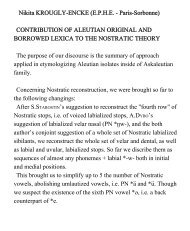

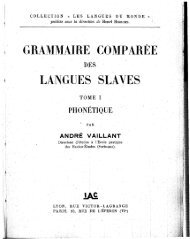

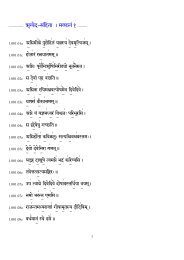
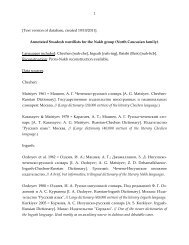
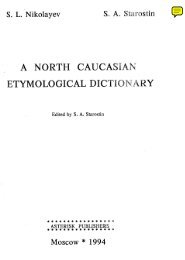
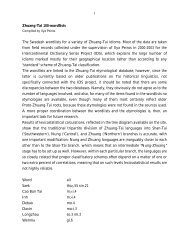

![Sino-Caucasian [comparative glossary]](https://img.yumpu.com/7303174/1/184x260/sino-caucasian-comparative-glossary.jpg?quality=85)
